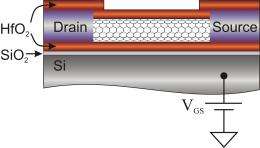January 26, 2009 feature
Carbon-Nanotube Memory that Really Competes

(PhysOrg.com) -- Researchers in Finland have created a form of carbon-nanotube based information storage that is comparable in speed to a type of memory commonly used in memory cards and USB "jump" drives.
The group's memory scheme has a write-erase time of 100 nanoseconds, which is about 100,000 times faster than previously reported carbon-nanotube memory, and retains this ability over more than 10,000 write-erase cycles. The work is reported in the January 16, 2009, online edition of Nano Letters.
"In terms of speed and endurance, our memory structure is as good as the commercially available Flash memory technologies," said Helsinki University of Technology physicist Päivi Törmä, the paper's corresponding author, to PhysOrg.com.
The memory scheme stores information using single-walled carbon-nanotube transistors, specifically field-effect transistors, which are among the fastest carbon-nanotube electrical components. Each transistor consists of four key parts, the gate, source, drain, and substrate.
As a substrate, Törmä and her colleagues chose a silicon wafer. In collaboration with Finnish technology-equipment company Beneq Oy, they applied a 20-nanometer-thick layer of hafnium oxide using atomic layer deposition, a technique used to deposit materials in very thin layers. The hafnium oxide separates the substrate, which was also used as the gate in this case, from the rest of the structure. Choosing hafnium dioxide as the gate "dielectric" material—an insulator placed between two conductors to separate them—appears to be the key to the device's fast operation, as it can trap and release charge very quickly and efficiently.
On top of the hafnium-oxide layer, the group deposited a few drops of a carbon-nanotube solution, produced using commercially available nanotubes with diameters between 1.2 and 1.5 nanometers and lengths of 100 to 360 nanometers. Using an atomic force microscope, they identified nanotubes with the proper alignment; only those nanotubes became transistors. They then created source and drain electrodes for each nanotube using the metal palladium, with the nanotube forming the transistor's conductive channel.
Finally, the researchers deposited another 20-nanometer layer of hafnium oxide on top of the nanotube transistor, to "passivate" the surface, preventing unwanted reactions.
"The fast memory operation we have demonstrated could potentially also be realized using other carbon materials, such as carbon-nanotube bundles or graphene," said Törmä.
Each transistor stores information based on whether current is running through it. When the voltage applied across the transistor reaches a certain threshold, current flows, which can represent one bit of information, either a "0" or a "1" (bit is short for binary digit). For example, when the transistor is conducting it may represent a "1," and when not conducting, a "0."
Each transistor can store information for about 150,000 seconds, or about 42 hours. This is quite short, although Törmä and her group think they can improve it by adding an oxide layer between the gate and the nanotube.
Citation: Nano Lett., Article ASAP DOI: 10.1021/nl8029916
Copyright 2008 PhysOrg.com.
All rights reserved. This material may not be published, broadcast, rewritten or redistributed in whole or part without the express written permission of PhysOrg.com.




















